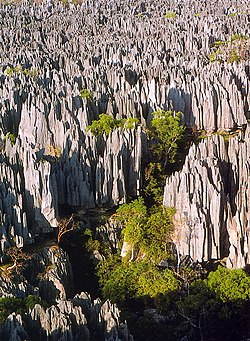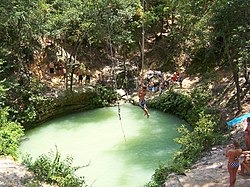Karst


Karst is a geological system of rocks where water has eroded (dissolved) the bedrock. If it is very extensive, karst can be a geographical or topographical feature. It is classed as a badland if it difficult to travel through the environment, which it often is.
Almost always, karst is formed in carbonate rocks, such as limestone or dolomite. Since carbonate sedimentary rocks are very common, karst areas occur all over the world.
Many karst regions display distinctive surface features, with sinkholes being the most common. However, karst surface features may be absent where the soluble rock is mantled (covered), such as by a non-soluble rock strata on top of the carbonate strata. Some karst regions include thousands of caves, and the water is generally underground.
The world's largest karst area is the Nullarbor Plain, part of the area of flat, almost treeless, dry country of southern Australia. It is on the Great Australian Bight coast with the Great Victoria Desert to its north. It is the world's largest single exposure of limestone bedrock, and occupies an area of about 200,000 square kilometres (77,000 sq mi).[1] At its widest point, it stretches about 1,100 kilometres (684 mi) from east to west across the border region between South Australia and Western Australia.
Sinkholes
Many parts of the world suffer from sinkholes. These form when karsts are underground. A sinkhole is a depression or hole in the ground caused by a collapse of the surface layer.[2]
Beneath the flat surface of the land in Florida, Guatemala City and elsewhere are vast systems of limestone. Water running through the limestone is dissolving the limestone away, leaving huge caverns. Without warning, huge holes appear in the surface, causing great damage. Practically the whole of Florida is sitting on a gigantic karst system,[3] as are several countries in Central America. The area round Tampa is especially at risk, and there is a huge karst system under Mexico, including Mexico City. According to a senior geochemist, there are as many as 15,000 sinkholes in Illinois.[4]
The world's deepest sinkhole is China's Xiaozhai Tienkeng at 2172ft (662m).
The Qattara Depression in Egypt is part of the Libyan Desert. It is roughly 50 miles (80km) by 75 miles (121km) in surface area. It is the world's largest natural sinkhole. It lies below sea level and is covered with salt pans, sand dunes and salt marshes.
Karst aquifers
In the United States, about 40% of the groundwater used for drinking comes from karst aquifers. Well-known examples are Carlsbad Caverns and Mammoth Cave. Karst aquifers are a vital resource in the US. About 20 percent of the land surface in the US is karst. Other parts of the world with large areas of karst include the Caribbean, China, and Australia.
The karst hydrogeology is a network of fissures, fractures, and runways in permeable rock. Most of inflow occurs through a network of openings. Groundwater is held in storage in the rocks. Karst is common also in Mexico, especially near where the meteorite hit in the Yucatan. There are also large areas of karst in the Caribbean, China, and Australia.
KarstSinkholes Media
Typical karst terrain of the Dinaric Alps
Li Jiang fengcong (cone karst) in Guilin as part of the South China Karst
Karst formation of the Serra de Tramuntana
Doline in the causse de Sauveterre, Lozère, France
A limestone deposit in the Dinaric Alps near Sinj, Croatia
Kostivere karst area in Estonia
Drone video of Kostivere karst area in Estonia (2021)
Related pages
References
- ↑ "Across the Nullarbor Plain". Kevin's Wilderness Journeys. 7 June 2004. Archived from the original on 10 October 2007.
- ↑ Who, What, Why: How are sinkholes formed? BBC News. [1]
- ↑ Stewart, Iain 2014. Sinkholes: a deadly threat from Florida's 'underworld'. BBC News Science & Environment. [2]
- ↑ Illinois golfer plunges down sinkhole on the 14th. BBC News 13 March 2013. [3]













